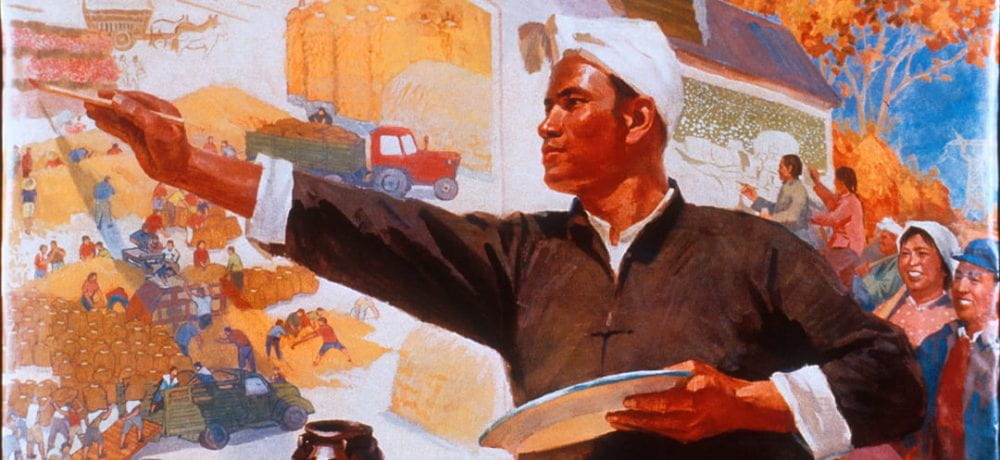Li Hua, Raging Tide I: Struggle, woodcut, Dimensions 22 x 16 in. (55.9 x 40.6 cm), 1947. Source: https://www.metmuseum.org/art/collection/search/77098
Li Hua’s “Raging Tide I: Struggle” is a woodcut print that portrays three strained figures laboring in an agricultural field. These men appear to be dragging a plow through the barren fields of rural China. Both the facial expressions and body language of these men reflect the agony these men are experiencing while working in the fields. The viewer can almost sympathize with these toured souls, presumably forced to cultivate this land for their feudal master. Li Hua combines western influence of German expressionism with traditional woodcut print to create a masterpiece.
Li Hua directly references the Peasants’ War series by the German Expressionist Käthe Kollwitz (1867–1945) in this work. But, at the same time, his work refers to the social turmoil in China during their Civil War. Li Hua provides social commentary that critiques the traditional Chinese life in the rural countryside. Li Hua addresses these issues with a sympathetic and humanitarian touch to his artwork. In this work he reflects the harsh and unfair realities of Chinese feudalism through the pain and agony of the working class peasants. Although Li Hua was not officially a part of CCP until 1953, his works were largely associated with their movement.
Li Hua used woodcut print for art because he believed that it was the best medium to portray social and political upheavals and to promote change, because of its simple black and white nature. The introduction to the modern woodcut movement originated from Lu Xun. In the late 1920’s Lu Xun introduced the modern Western woodcuts in China from German graphic artist, Käthe Kollwitz (1867-1945) and the Russian engraver, Vladimir A. Favorsky (1886-1964). He considered Western woodcuts a counterpart to the traditional Chinese woodcut prints and combined the two techniques to vividly capture social and political issues in China. Lu Xun proved to be immensely influential to modern Chinese art and introduced technique of woodcut printing to artists such as Li Hua. Many artists followed Lu Xun’s ideals and used the woodcut to promote social/political change and modernization in China.
Citations:
Hung, Chang-Tai. “Two Images of Socialism: Woodcuts in Chinese Communist Politics.” Comparative Studies in Society and History, vol. 39, no. 1, 1997, pp. 34–60.
Lin, Pei-Yin. Print, Profit, and Perception : Ideas, Information and Knowledge in Chinese Societies, 1895-1949, edited by Weipin Tsai, BRILL, 2014.



Great analysis, James! The way in which you analyzed the facial expressions and physical body language of the main characters of this piece of work is very insightful. An interesting correlation is acknowledged by comparing the harsh reality of rural life and agricultural work with the realities of Chinese feudalism, a rigid concept which Mao sought to destroy in his liberation of China from KMT rule. When an individual comes across an image such as this woodcut, they will be able to understand the toil and plight of those rural workers and be able to surmise that the goal of the image is to stress that under Communist rule, no one will be subject to such harsh realities and working conditions (which of course was not the case, but that is another point). Your analysis will certainly encourage me to look more closely at the facial expressions and context of images in order to have a deeper understanding of what the meaning behind the image may truly be. In my artist’s paintings, while there is not overtly obvious expressions and inuendos, analyzing facial reactions and expressions will certainly make accurately interpreting his pieces a more feasible task. Thanks again!